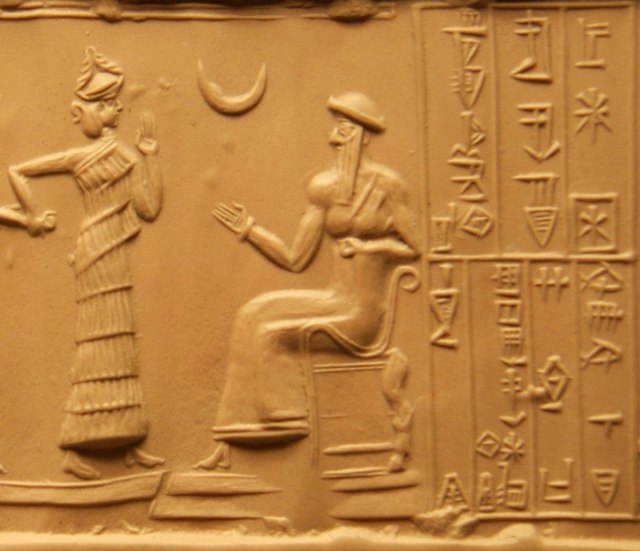Ur-Nammu founded the Sumerian Third Dynasty of Ur, in southern Mesopotamia, following several centuries of Akkadian and Gutian rule. His main achievement was state-building, and Ur-Nammu is chiefly remembered today for his legal code, the Code of Ur-Nammu, the oldest known surviving example in the world. He held the titles of "King of Ur, and King of Sumer and Akkad".
Enthroned King Ur-Nammu, founder of the Third Dynasty of Ur, on a cylinder seal. Inscription of the upper segment: "Ur-Nammu, the Great man, King of Ur". The name of King Ur-Nammu (𒌨𒀭𒇉) appears vertically in the upper right corner.
Ur-Nammu built the great Ziggurat of Ur.
Ur-Nammu dedication tablet for the Temple of Inanna in Uruk. Inscription "For his lady Inanna, Ur-Nammu the mighty man, King of Ur and King of Sumer and Akkad": 𒀭𒈹 Dinanna.... "For Inanna-" 𒎏𒂍𒀭𒈾 Nin-e-an-na.... "Ninanna," 𒎏𒀀𒉌 NIN-a-ni.... "his Lady" 𒌨𒀭𒇉 UR-NAMMU.... "Ur-Nammu" 𒍑𒆗𒂵 NITAH KALAG ga.... "the mighty man" 𒈗𒋀𒀊𒆠𒈠 LUGAL URIM KI ma.... "King of Ur" 𒈗𒆠𒂗𒄀𒆠𒌵𒆤 LUGAL ki en gi ki URI ke.... "King of Sumer and Akkad"
Stele of Ur-Nammu, University of Pennsylvania Museum of Archeology and Anthropology.
Sumer is the earliest known civilization, located in the historical region of southern Mesopotamia, emerging during the Chalcolithic and early Bronze Ages between the sixth and fifth millennium BC. Like nearby Elam, it is one of the cradles of civilization, along with Egypt, the Indus Valley, the Erligang culture of the Yellow River valley, Caral-Supe, and Mesoamerica. Living along the valleys of the Tigris and Euphrates rivers, Sumerian farmers grew an abundance of grain and other crops, a surplus which enabled them to form urban settlements. The world's earliest known texts come from the Sumerian cities of Uruk and Jemdet Nasr, and date to between c. 3350 – c. 2500 BC, following a period of proto-writing c. 4000 – c. 2500 BC.
The Blau Monuments combine proto-cuneiform characters and illustrations of early Sumerians, Jemdet Nasr period, 3100–2700 BC. British Museum.
Enthroned Sumerian king of Ur, possibly Ur-Pabilsag, with attendants. Standard of Ur, c. 2600 BC.
Portrait of a Sumerian prisoner on a victory stele of Sargon of Akkad, c. 2300 BC. The hairstyle of the prisoners (curly hair on top and short hair on the sides) is characteristic of Sumerians, as also seen on the Standard of Ur. Louvre Museum.
A pottery jar from the Late Ubaid Period








